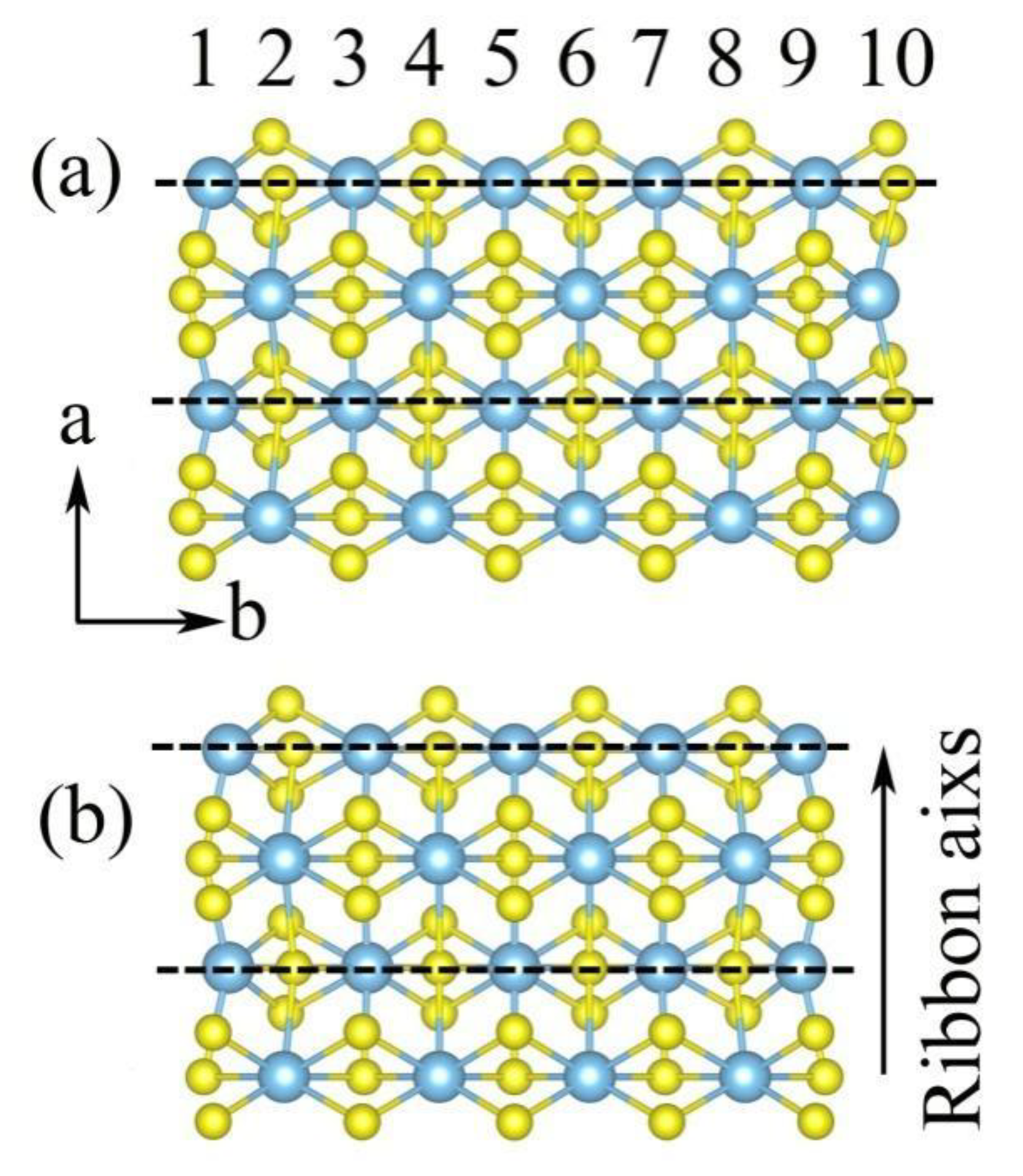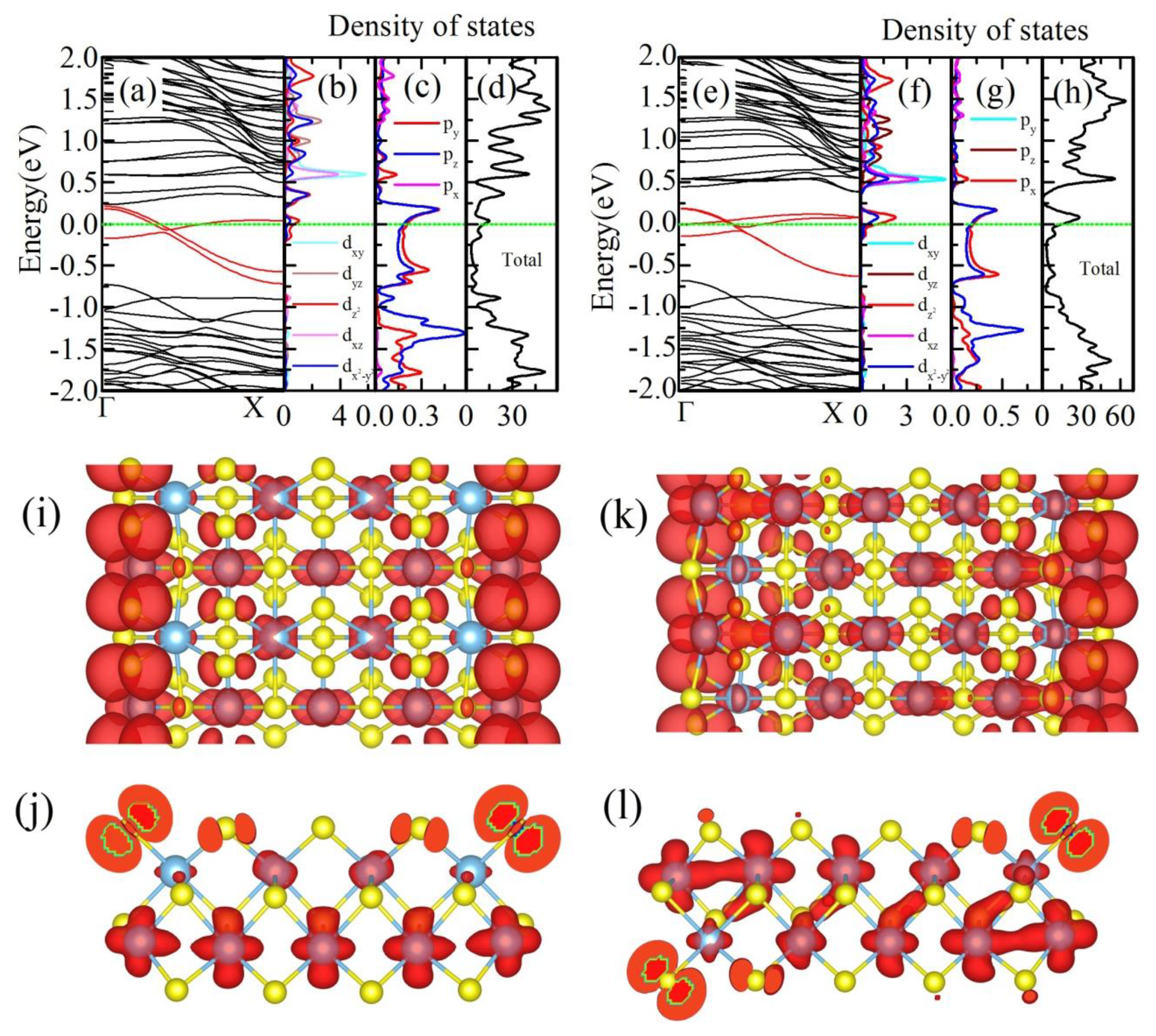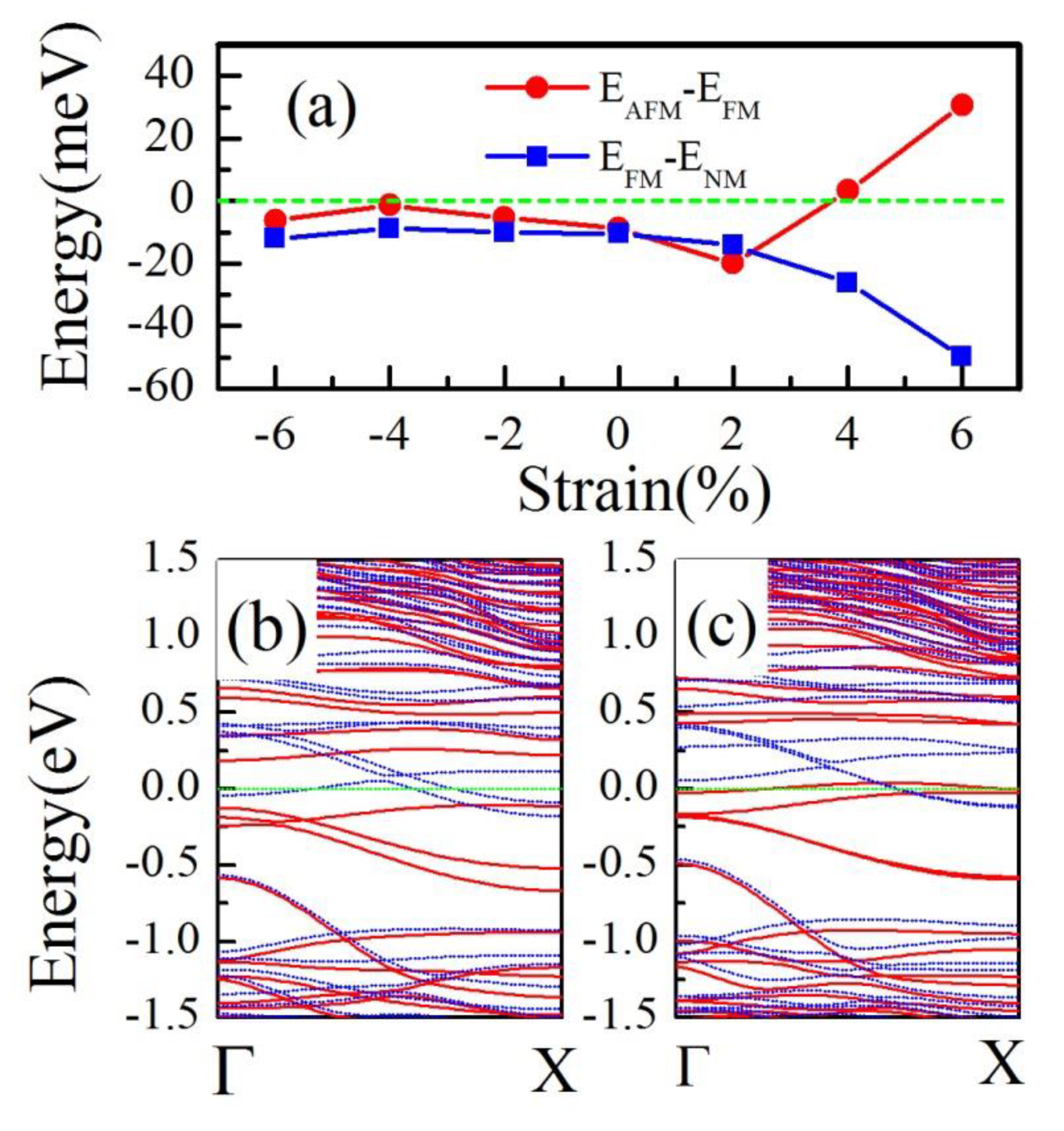Magnetic Behavior in TiS3 Nanoribbon
Abstract
1. Introduction
2. Methods
3. Results and Discussion
4. Conclusions
Author Contributions
Funding
Conflicts of Interest
References
- Dahal, B.R.; Dulal, R.P.; Pegg, I.L.; Philip, J. Electrical transport and magnetic properties of cobalt telluride nanostructures. J. Vac. Sci. Technol. B 2016, 34, 051801. [Google Scholar] [CrossRef]
- Dulal, R.P.; Dahal, B.R.; Forbes, A.; Bhattarai, N.; Pegg, I.L.; Philip, J. Ferromagnetism in Fe2XrAl nanowires. J. Vac. Sci. Technol. B 2018, 36, 022902. [Google Scholar] [CrossRef]
- Liang, D.; DeGrave, J.P.; Stolt, M.J.; Tokura, Y.; Jin, S. Current-driven dynamics of skyrmions stabilized in MnSi nanowires revealed by topological Hall effect. Nat. Commun. 2015, 6, 8217. [Google Scholar] [CrossRef] [PubMed]
- Stano, M.; Fruchart, O. Magnetic Nanowires and Nanotubes. Handb. Magn. Mater. 2018, 27, 155–267. [Google Scholar]
- Novoselov, K.S.; Geim, A.K.; Morozov, S.V.; Jiang, D.; Zhang, Y.; Dubonos, S.V.; Grigorieva, I.V.; Firsov, A.A. Electric Field Effect in Atomically Thin Carbon Films. Science 2004, 306, 666. [Google Scholar] [CrossRef]
- Zhang, Y.; Tan, Y.; Stormer, H.; Kim, P. Experimental observation of the quantum Hall effect and Berry’s phase in graphene. Nature 2005, 438, 201. [Google Scholar] [CrossRef]
- Xia, Y.; Yang, P.; Sun, Y.; Wu, Y.; Mayers, B.; Gates, B.; Yin, Y.; Kim, F.; Yan, H. Mediated Synthesis of Fe2O3 Nanorods. Adv. Mater. 2003, 15, 353. [Google Scholar] [CrossRef]
- Barone, V.; Hod, O.; Scuseria, G.E. Electronic Structure and Stability of Semiconducting Graphene Nanoribbons. Nano Lett. 2006, 6, 2748–2754. [Google Scholar] [CrossRef]
- Son, Y.-W.; Cohen, M.L.; Louie, S.G. Energy gaps in graphene nanoribbons. Phys. Rev. Lett. 2006, 97, 216803. [Google Scholar] [CrossRef]
- Han, M.Y.; Özyilmaz, B.; Zhang, Y.; Kim, P. Energy Band-Gap Engineering of Graphene Nanoribbons. Phys. Rev. Lett. 2007, 98, 206805. [Google Scholar] [CrossRef]
- Li, X.L.; Wang, X.R.; Zhang, L.; Lee, S.W.; Dai, H.J. Chemically derived, ultrasmooth graphene nanoribbon semiconductors. Science 2008, 319, 1229–1232. [Google Scholar] [CrossRef] [PubMed]
- Fujita, M.; Wakabayashi, K.; Nakada, K.; Kusakabe, K.J. Physical Peculiar localized state at zigzag graphite edge. Soc. Jpn. 1996, 65, 1920–1923. [Google Scholar] [CrossRef]
- Nakada, K.; Fujita, M.; Dresselhaus, G.; Dresselhaus, M.S. Edge state in graphene ribbons: Nanometer size effect and edge shape dependence. Phys. Rev. B 1996, 54, 17954–17961. [Google Scholar] [CrossRef] [PubMed]
- Son, Y.-W.; Cohen, M.L.; Louie, S.G. Half-metallic graphene nanoribbons. Nature 2006, 444, 347–349. [Google Scholar] [CrossRef] [PubMed]
- Hod, O.; Barone, V.; Peralta, J.E.; Scuseria, G.E. Enhanced half-metallicity in edge-oxidized zigzag graphene nanoribbons. Nano Lett. 2007, 7, 2295–2299. [Google Scholar] [CrossRef]
- Kan, E.J.; Li, Z.Y.; Yang, J.L.; Hou, J.G. Half-metallicity in edge-modified zigzag graphene nanoribbons. J. Am. Chem. Soc. 2008, 130, 4224–4225. [Google Scholar] [CrossRef] [PubMed]
- Li, Y.F.; Zhou, Z.; Shen, P.W.; Chen, Z.F. Spin Gapless Semiconductor−Metal−Half-Metal Properties in Nitrogen-Doped Zigzag Graphene Nanoribbons. ACS Nano 2009, 3, 1952–1958. [Google Scholar] [CrossRef]
- Dutta, S.; Pati, S.K. Half-metallicity in undoped and boron doped graphene nanoribbons in the presence of semilocal exchange-correlation interactions. J. Phys. Chem. B 2008, 112, 1333–1335. [Google Scholar] [CrossRef]
- Lin, X.; Ni, J. Half-metallicity in graphene nanoribbons with topological line defects. Phys. Rev. B 2011, 84, 075461. [Google Scholar] [CrossRef]
- Barone, V.; Peralta, J.E. Magnetic boron nitride nanoribbons with tunable electronic properties. Nano Lett. 2008, 8, 2210–2214. [Google Scholar] [CrossRef]
- Li, Y.F.; Zhou, Z.; Zhang, S.B.; Chen, Z.F. MoS2 Nanoribbons: High Stability and Unusual Electronic and Magnetic Properties. J. Am. Chem. Soc. 2008, 130, 16739. [Google Scholar] [CrossRef] [PubMed]
- Hu, T.; Hong, J. Electronic structure and magnetic properties of zigzag blue phosphorene nanoribbons. J. Appl. Phys. 2005, 118, 054301. [Google Scholar] [CrossRef]
- Du, Y.P.; Liu, H.M.; Xu, B.; Sheng, L.; Yin, J.; Duan, C.G.; Wan, X.G. Unexpected Magnetic Semiconductor Behavior in Zigzag Phosphorene Nanoribbons Driven by Half-Filled One Dimensional Band. Sci. Rep. 2015, 5, 8921. [Google Scholar] [CrossRef] [PubMed]
- Botello-Méndez, A.R.; Loópez-Uriías, F.; Terrones, M.; Terrones, H. Magnetic Behavior in Zinc Oxide Zigzag Nanoribbons. Nano Lett. 2008, 8, 1562. [Google Scholar]
- Island, J.O.; Buscema, M.; Barawi, M.; Clamagirand, J.M.; Ares, J.R.; Sanchez, C.; Ferrer, I.J.; Steele, G.A.; van der Zant, H.S.J.; Castellanos-Gomez, A. Ultrahigh Photoresponse of Few-Layer TiS3 Nanoribbon Transistors. Adv. Opt. Mater. 2014, 2, 641–645. [Google Scholar] [CrossRef]
- Island, J.O.; Buscema, M.; Biele, R.; Almazan, A.; Clamagirand, J.M.; Ares, J.R.; Sanchez, C.; van der Zant, H.S.; Álvarez, J.V.; D’Agosta, R.; et al. TiS3 Transistors with Tailored Morphology and Electrical Properties. Adv. Mater. 2015, 27, 2595–2601. [Google Scholar] [CrossRef]
- Pawbake, A.S.; Island, J.O.; Flores, E.; Ares, J.R.; Sanchez, C.; Ferrer, I.J.; Jadkar, S.R.; van der Zant, H.S.; Castellanos-Gomez, A.; Late, D.J. Temperature-Dependent Raman Spectroscopy of Titanium Trisulfide (TiS3) Nanoribbons and Nanosheets. ACS Appl. Mater. Interfaces 2015, 7, 24185–24190. [Google Scholar] [CrossRef]
- Molina-Mendoza, A.J.; Barawi, M.; Biele, R.; Flores, E.; Ares, J.R.; Sanchez, C.; Rubio-Bollinger, G.; Agrat, N.; D’Agosta, R.; Ferrer, I.J.; et al. Electronic Bandgap and Exciton Binding Energy of Layered Semiconductor TiS3. Adv. Electron. Mater. 2015, 1, 1500126. [Google Scholar] [CrossRef]
- Dai, J.; Zeng, X.C. Titanium trisulfide monolayer: Theoretical prediction of a new direct-gap semiconductor with high and anisotropic carrier mobility. Angew. Chem.-Int. Ed. 2015, 54, 7572. [Google Scholar] [CrossRef]
- Kang, J.; Wang, L.W. Robust band gap of TiS3 nanofilms. Phys. Chem. Chem. Phys. 2016, 18, 14805. [Google Scholar] [CrossRef]
- Kang, J.; Sahin, H.; Ozaydin, D.; Senger, R.T.; Peeters, F.M. TiS3 nanoribbons: Width-independent band gap and strain-tunable electronic properties. Phys. Rev. B 2015, 92, 075413. [Google Scholar] [CrossRef]
- Ce, H.; Zhang, E.Z.; Yuan, X.; Wang, W.Y.; Liu, Y.W.; Zhang, C.; Ling, J.W.; Liu, S.S.; Xiu, F.X. Tunable charge density wave in TiS3 nanoribbons. Chin. Phys. B 2017, 26, 067302. [Google Scholar] [CrossRef]
- Lipatov, A.; Loes, M.J.; Lu, H.D.; Dai, J.; Patoka, P.; Vorobeva, N.S.; Muratov, D.S.; Ulrich, G.; Kästner, B.; Hoehl, A.; et al. Quasi-1D TiS3 Nanoribbons: Mechanical Exfoliation and Thickness-Dependent Raman Spectroscopy. ACS Nano 2018, 12, 12713–12720. [Google Scholar] [CrossRef] [PubMed]
- Kresse, G.; Hafner, J. Ab initio molecular dynamics for liquid metals. Phys. Rev. B 1993, 47, 558(R). [Google Scholar] [CrossRef] [PubMed]
- Kresse, G.; Furthmuller, J. Efficient iterative schemes for ab initio total-energy calculations using a plane-wave basis set. Phys. Rev. B 1996, 54, 11169. [Google Scholar] [CrossRef]
- Perdew, J.P.; Burke, K.; Ernerhof, M. Generalized Gradient Approximation Made Simple. Phys. Rev. Lett. 1997, 77, 3865. [Google Scholar] [CrossRef]
- Furuseth, S.; Brattas, L.; Kjekshus, A. Crystal Structures of TiS3, ZrS3, ZrSe3, ZrTe3, HfS3 and HfSe3. Acta Chem. Scand. 1975, 29, 623. [Google Scholar]
- Stoner, E.C. Collective electron specific heat and spin paramgnetism in metals. Proc. R. Soc. A 1936, 154, 656. [Google Scholar]




© 2019 by the authors. Licensee MDPI, Basel, Switzerland. This article is an open access article distributed under the terms and conditions of the Creative Commons Attribution (CC BY) license (http://creativecommons.org/licenses/by/4.0/).
Share and Cite
Lai, S.; Du, Y. Magnetic Behavior in TiS3 Nanoribbon. Materials 2019, 12, 3501. https://doi.org/10.3390/ma12213501
Lai S, Du Y. Magnetic Behavior in TiS3 Nanoribbon. Materials. 2019; 12(21):3501. https://doi.org/10.3390/ma12213501
Chicago/Turabian StyleLai, Shengqiang, and Yongping Du. 2019. "Magnetic Behavior in TiS3 Nanoribbon" Materials 12, no. 21: 3501. https://doi.org/10.3390/ma12213501
APA StyleLai, S., & Du, Y. (2019). Magnetic Behavior in TiS3 Nanoribbon. Materials, 12(21), 3501. https://doi.org/10.3390/ma12213501



